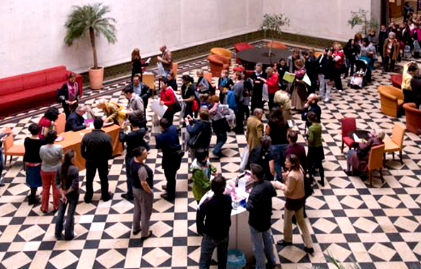Volunteering at the Museum
European Year of Volunteering 2011
It is probable that most of us don’t even think how much organizing it takes to establish voluntary work and what the outcome can be of the energy and time spent on the establishing.
| Csordás Izabella |
2011-04-16 23:01 |
 We hear about it ever so often, and use the term more and more frequently. It is probable that most of us don’t even think how much organizing it takes to establish voluntary work and what the outcome can be of the energy and time spent on the establishing. In the following the Volunteer Program of the Museum of Fine Art is presented.
We hear about it ever so often, and use the term more and more frequently. It is probable that most of us don’t even think how much organizing it takes to establish voluntary work and what the outcome can be of the energy and time spent on the establishing. In the following the Volunteer Program of the Museum of Fine Art is presented.
The Creation of Added Value: Organizing Volunteers
Six years ago only a few Hungarian citizens took part in the education of voluntary exhibition guides. This program has been going on since its very start and the rate of home participants has increased constantly. The Voluntary Program established in 2006 focuses on those Hungarian helpers, who want to improve the services of the museum in different areas. When the program was first announced 145 people volunteered. After a careful selection 60 participants began their helping activities in the museum.
At the time other Hungarian museums did not have such courses or programs. In 2010 the Ferenc Móra Museum in the town of Szeged and the Petőfi Literary Museum followed the example of the Fine Art Museum.
2011 is the European Year of Volunteers in the EU. And thanks to this fact more attention is given to this movement, the tradition of which in Hungary and other post-communist countries could not develop as it flourished in Western Europe.
The voluntary program of the Tate Gallery, London was established in 1977, that of the Museum of Modern Arts, New York in 1984.
In Hungary the first legal regulation concerning the employment of volunteers was implemented only in 2005.
Today several grants scholarships are there to make volunteers and museums learn and gain more experience on an international level. The coordinator of the Voluntary Program of the Fine Art Museum offers the following possibilities to all those interested in voluntary museum work:
Results and Co-ordination
Volunteers in the framework of the Voluntary Programs of the Fine Art Museum have helped the museum for 4 years. The museum received the team and was enriched with only their voluntary contribution but with new ideas, their enthusiasm and energy. A new community formed itself, the more than 100 members of which help the museum in several ways and areas.
The information desk is wholly run by volunteers: giving information to visitors, the giving out of audio-guides, the registration of the donators are carried out by the volunteers. Several of them take part in educational programs for children. The volunteers of the library do the cataloguing and other administrative work. The latest project of the Voluntary Program started in the autumn of 2010: the visitors can literally lay their hands on authentic, original Egyptian works-of-art, while the objects are being described by volunteers.
Visitors said:
“It was unbelievable that I could take two thousand-years-old objects in my hands and examine them from all sides. All the information the volunteers told us were quite fascinating also.”
The coordination of volunteers has several elements which are crucial to the success of the program. One of the most important things is that the volunteers are responsible for the completion of the task they undertook. The realization and mutual understanding of the said feature is the basis of the cooperation. It is equally important to understand that the work of the volunteers is not free of any charge, it does not manages itself, on the contrary, it needs minute planning.
In the long run the keeping of voluntary human resources can become one of the key factors of institutional sustainability.
During the past years a management model has been developed at the Fine Art Museum, which covers the complex tasks of the volunteer coordinator and helps their integration into the system of the whole institution. In Hungary voluntary work is still regarded with suspicion, the role of the volunteer coordinator is underestimated, although a position like this takes a personality of high intellect and experience from several fields. It is imperative that more and more museums realize the significance of volunteers and voluntary work when completing their own tasks and assignments on a daily basis.
The author is the head of department of public services, founder and coordinator of the Volunteer Program of the Museum of Fine Arts